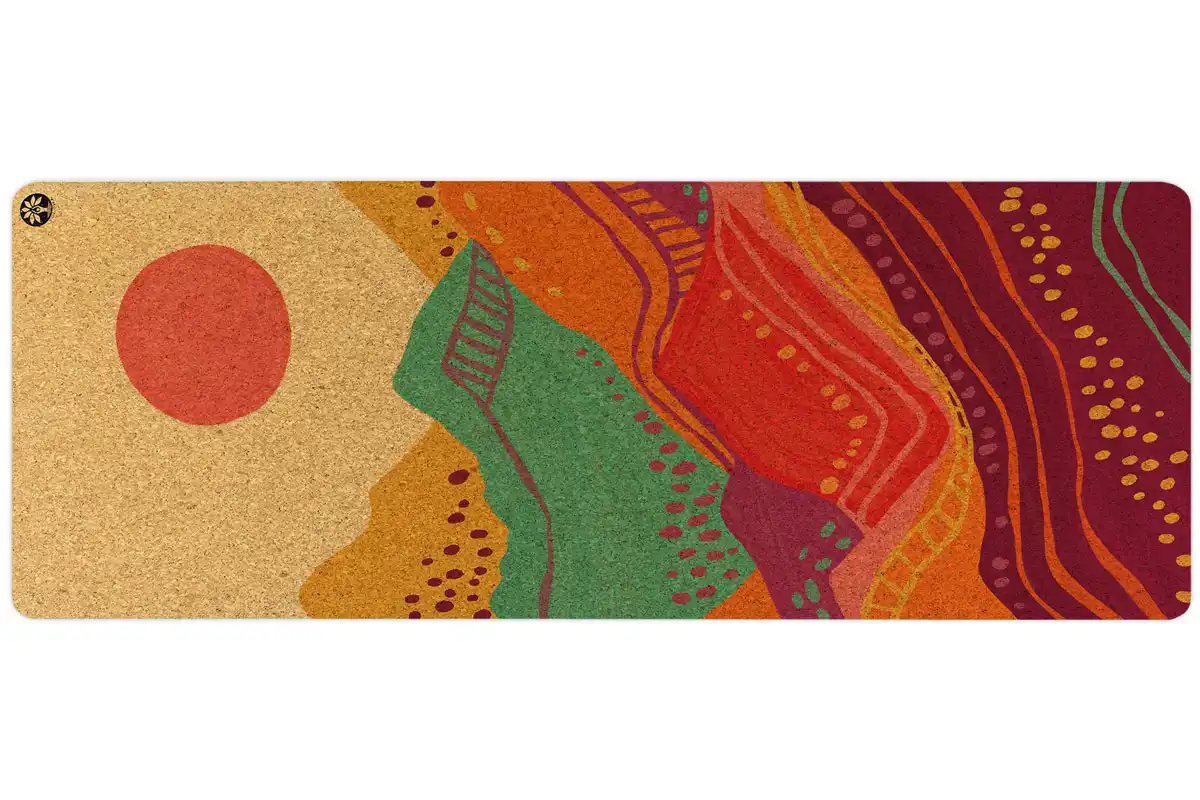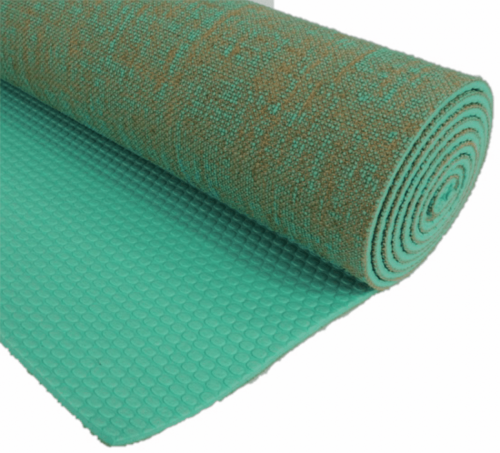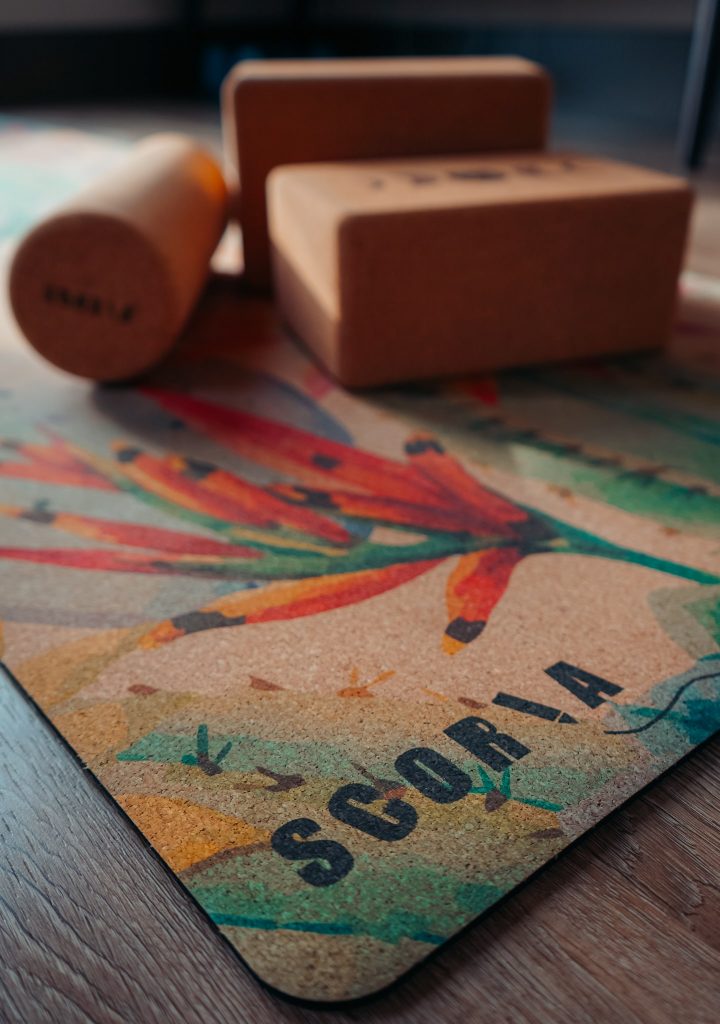You might be surprised to learn that many yoga mats are made from plastics that are not only bad for the environment but also slightly toxic.
Materials used in many yoga mats, like PVC and hardened rubber, and been tied to health effects in industrial contexts, although there isn’t much research done on their effect on people in yoga classes.
That said, why risk it? Plus, avoiding these materials and opting for eco-friendly yoga mats will also lower your environmental footprint.
Having ditched the plastic myself, I now own three environmentally friendly yoga mats. I’ve written about each of them below, as well as a few I’ve tried at yoga studios and some cheaper alternatives to the ones I own. I hope this helps you find the best eco-friendly yoga mat for yourself!
🌟 My favourite yoga mat on this list is Scoria World Cork Yoga Mat (I have the Botanicals design, which is gorgeous). Scoria World has set me up with a 10% discount code if you’d like one of their yoga mats. The discount code is TRIPPER10!
Best Eco-Friendly Yoga Mats – Comparison Chart
I’ve listed the specs for each of the eco-friendly yoga mats reviewed in this post in the chart below.
| Picture | Name | Material | Eco Score | Thickness | Price |
|---|---|---|---|---|---|
 | Scoria Cork Yoga Mat | Cork and Natural Rubber | Excellent | 4.5 mm | $$$ |
 | Big Raven Yoga Mat | Natural Rubber and Micro Suede | Excellent | 4.5 mm | $$$$ |
 | Yoloha Original Air Cork Yoga Mats | Cork and Plant Foam | Excellent | 6 mm | $$ |
 | Live Well 360 Organic Cotton Yoga Mat | Organic Cotton | Excellent | 4 mm | $$ |
 | B Yoga Cork Yoga Mat | Cork and Natural Rubber | Great | 4 mm | $$$ |
 | Manduka eKO Yoga Mat | Natural Rubber | Great | 4 mm | $$ |
 | Jade Natural Rubber | Natural Rubber | Great | 4 mm | $ |
 | Gaiam Jute Yoga Mat | Jute and PER | Good | 5 mm | $ |
 | Kakaos Pure Jute | Jute and Natural Rubber | Good | 6 mm | $ |
 | Gaiam Cork Yoga Mat | Cork and TPE | Good | 5 mm | $ |
This post may contain affiliate links. If you make a purchase through one of these links, I may receive a small commission at no extra cost to you. Your support is much appreciated! You can learn more by reading my full disclosure.
🌿 The ‘Eco Score‘ is a rating I’ve made up to summarize how environmentally friendly and safe the yoga mats are. It’s actually very difficult to find 100% eco-friendly yoga mats and those that are can be expensive. So I’ve included some ‘Good’ yoga mats that are mostly eco-friendly yoga mats but come in at a much more accessible price point.
Best Eco-Friendly Yoga Mats – Top Picks
⭐ Best Overall Eco-Friendly Yoga Mats: Scoria World Cork Yoga Mat
🍾 Best Cork Yoga Mat: Scoria World Cork Yoga Mat
🌲 Best Natural Rubber Yoga Mat: Jade Natural Rubber
🏅 Best Performance: Big Raven Yoga Mat
💕 My Favourite Eco-Friendly Yoga Mats: Scoria Cork Yoga Mat and Big Raven Yoga Mat

Buying Considerations for Eco-Friendly Yoga Mats
☢️ Toxic Yoga Mat Materials
The first thing we need to consider is the material the yoga mat is made from. My background is in chemistry, so I tend to geek out on materials, but I’ll do my best to lay it all out clearly.
PVC (Polyvinyl Chloride)
Most yoga mats are made from polyvinyl chloride, which is a kind of plastic. PVC is toxic and it off-gases.
What is off-gassing? Off-gassing occurs when a material releases volatile organic compounds (VOCs) or polycyclic aromatic hydrocarbons (PAHs) into the air. You can sort of think of it like chemicals leaching into the water in a plastic water bottle, except that the chemicals are leaching into the air. The VOCs and PAHs that are released into the air are usually harmful to human health.
In high doses or prolonged exposure, off-gassing VOCs and PAHs can cause headaches, nausea, neurological issues and more. You probably won’t experience these symptoms from using a yoga mat, but why risk any exposure when there are non-toxic yoga mats in the market?
And despite its toxicity, PVC is used in everything because it is cheap and easy to use. What makes PVC even worse is that it is treated with heavy chemicals (lead, cadmium, ) during the production process in order to make it even easy to use. From a health standpoint, it’s best to avoid PVC.
From an environmental standpoint, PVC puts harmful chemicals into the air and water during production, and it is non-recyclable and doesn’t degrade. The only way to get rid of PVC is to incinerate it, putting all those toxic chemicals in the air.
Polyester
Many yoga brands now use polyester instead of PVC because polyester is much less harmful to human health. That said, polyester is terrible for the environment. Producing polyester is energy-intensive (hello greenhouse gases!) and produces toxic by-products like sulphur oxide, acetaldehyde and 1,4-dioxane that end up in the air. It also produces toxic by-products that end up in the wastewater, like acids and ammonia.
So, while polyester is better than PVCs from a health standpoint, it is still bad for the environment.
Hardened Rubber
Instead of plastic, some yoga mats are made from vulcanized rubber (a hardened rubber that is more durable and resistant to abrasion). There isn’t much research on vulcanized rubber in the context of yoga mats, however, vulcanized rubber has been tied to negative health effects in the tire industry.
This is because hardening rubber creates chemicals like nitrosamines, an organic compound that is known to be carcinogenic.

🍃 Non-Toxic & Eco-Friendly Yoga Mat Materials
Natural Rubber
There are eco-friendly yoga mats made from natural (non-hardened) rubber. It’s still possible the yoga mat is treated with harmful chemicals, so you’ll want to check the brand and materials carefully. Natural rubber provides a good grip, but not a great grip. Jade Natural Rubber Yoga Mat is a good option. You’ll often find natural rubber on the bottom of yoga mats so the mat sticks to the floor and doesn’t move around, as is the case with the Big Raven Yoga Mat.
Cork
Cork is a great material for yoga mats because it has a naturally good grip – and the grip only gets better with moisture (excellent for those of us who sweat rivers during a hot yoga class). Cork is also naturally antimicrobial and doesn’t pick up odours the way plastic yoga mats do. You’ll want to ensure you are properly cleaning and caring for your yoga mat according to the brand’s instructions, as cork can crack if not taken care of. For cork yoga mats, I strongly recommend Scoria Cork Yoga Mat (the one I have) or Yoloha Aura Cork Yoga Mat (a cheaper alternative).
Jute
Jute is a natural fibre made from “flowering plants in the genus Corchorus”. Most people have never heard of it. Jute is naturally antimicrobial and doesn’t absorb sweat (no gross smells). It feels a lot like a normal yoga mat but lacks some of the cushioning. Jute is often blended with PER (polymer environment resin) which is usually just PVC, so you need to be careful when choosing a jute yoga mat. Kakakos Pure Jute is a good option, though I couldn’t find any independent tests for it.
Organic Cotton
If you’re transitioning from traditional plastic to a non-toxic yoga mat, you might find organic cotton a little too different. Organic cotton yoga mats are great for sweat absorption but don’t offer much cushioning (not great if you have bad knees) and tend to move around on the floor. That said, they can be great for improving grip in Bikram Yoga and they’re cozy to lie on during seated poses. Personally, I don’t like cotton yoga mats but the Live Well 360 Organic Cotton Yoga Mat is a good option if you’d like to try it.
Note: Ensure you’re using eco-friendly cleaning products when you’re cleaning any yoga mat! No point going through all the effort to find a plastic-free, non-toxic yoga mat and then wash it with harmful chemicals!

Best Eco-Friendly Yoga Mats – 2022 Reviews
Material: 100% natural cork and rubber
Dimensions: 6 ft x 2 ft x 4.5 mm (also available in 3.5 mm and 6 mm thickness)
Absolutely gorgeous non-toxic yoga mat. Cork is naturally anti-microbial and grippy (no towel needed).
This is my favourite yoga mat and the best cork yoga mat on the list. I was a little reluctant to try a cork yoga mat – I mostly do hot vinyasa yoga and sweat like a beast, so I find most yoga mats aren’t grippy enough, but I’ve been so pleased with Scoria. Also, isn’t it the most beautiful yoga mat you’ve ever seen?
The cork top is naturally grippy and gets grippier with moisture, meaning it actually improves with sweat. The top is smooth and comfortable to stand and kneel on. The standard thickness is 4.5 mm and they also have a 2 mm travel mat. Plus, oh my goodness, it is gorgeous. I love the warm pastel desert design.
🍃 What makes it so eco-friendly? It has a 100% natural cork top and a 100% natural rubber bottom with absolutely no TPE or PVC. The materials are also sustainably harvested and they ship with plastic-free packaging.
🔥 Also, if you are interested in purchasing one of Scoria’s yoga mats, don’t forget to use the code TRIPPER10 for 10% off your order! >>Click here to use the code!
Material: Brushed microfiber suede bonded to a biodegradable, recyclable, 100% natural tree rubber base
Dimensions: 6’ long x 2’ wide x 4.5mm thick
This is an excellent yoga mat with great grip and beautiful designs. Check out the collection by Rachel Pohl for yoga mats with beautiful designs.
If you like the feel and performance of PVC / polyester yoga mats, Big Raven is your best option for an eco-friendly alternative.
🌿 What makes this an eco-friendly yoga mat? The yoga mat is made from a brushed microfiber suede bonded to a biodegradable, recyclable, 100% natural tree rubber base.
Microfibre suede is a type of polyester-nylon blend, which we noted above can be harmful to the environment during its production. However, Big Raven has chosen to use polyester and nylon microfibers made from other recycled synthetics. Plus, the entire yoga mat is recyclable when you’re done with the mat. (This is why I’ve rated it as Good for the Eco-Score).
By using microfibre suede on the top of the yoga mat, Big Raven is able to get a yoga mat that is soft when dry and gets grippy with moisture (i.e. sweaty hands). This is the yoga mat that will look and feel like the yoga mats you’re used to, but is actually environmentally friendly!
I also own this yoga mat currently and I love it. It’s soft and smooth, but still grippy and the ends don’t curl up after you unroll it.
Materials: Cork
Dimensions: 72 x 26 or 80 x 26 inches x 6 mm thickness
If the Scoria World Cork Yoga Mat is out of your price range, the next best cork yoga mat I’d recommend is the Yoloha Cork Yoga Mat.
🌿 What makes this yoga mat eco-friendly? The top of the yoga mat is made from 100% sustainably sourced cork. The bottom is made from ‘plant foam’ which has the look and feel of a plastic-based foam, but is made from sugarcane!
The original is 6 mm thick, making it excellent for anyone who wants extra cushioning due to sore joints. The natural cork is grippy, especially in hot yoga classes or when damp with sweat. Yoloha yoga mats have gorgeous designs made from non-toxic dyes.
One great thing that Yoloha does is that you can order samples of the cork material to test at home before you commit to a mat. Seeing as they have a few thicknesses and cork types, this is a great way to ensure you’re happy with the feel of the mat before you purchase.
Materials: 100% organic cotton
Dimensions: 78 x 27 inches x 4 mm thickness
Yoga mats made from organic cotton are exceptionally environmentally friendly. Organic cotton can be grown and harvested sustainably, the carbon footprint is low and there aren’t any harmful chemical byproducts.
⛔ Personally, I don’t really like cotton yoga mats for my current yoga practice. Since I mostly do Vinyasa now, I find I slide all around and I need way more cushioning for my knees. If you have sensitive joints or like a little more comfort, you’ll likely find a cotton yoga mat too thin.
That said, when I was living in India and doing Iyengar yoga, we all used cotton yoga mats. In Iyengar yoga, you’re holding poses for WAY longer and it’s practiced at room temperature, so in that environment, I did like having a soft cotton mat to lie on.
I couldn’t find the exact yoga mat I used to use online, but this Live Well 360 one is very similar.
🌿 What makes this an eco-friendly yoga mat? The Live Well 360 is made from organic cotton, t’s handwoven in India and there are no chemical dyes or additives used. The yoga mat is even biodegradable at the end of its life.
I don’t have personal experience with this exact mat, so I can’t speak to its softness compared to my Iyengar mat. However, it does get very good customer reviews on how it feels.
Material: Pure jute top and natural rubber bottom
Dimensions: 68” x 24” x 6mm
There’s a yoga studio I used to go to back when I was travelling for work and they used Kakaos jute yoga mats. This was my first time using a jute yoga mat and I didn’t even know it wasn’t a regular yoga mat! I just thought it was a PVC yoga mat with a soft material on top for comfort.
Later on, I learned that jute, when used with natural rubber, is an environmentally friendly alternative to PVC yoga mats.
🌿 What makes this eco-friendly? The Kakaos Pure Jute yoga mat has a top layer made from natural jute and a bottom layer made from natural rubber. The jute is naturally grippy, which is super helpful in hot, sweaty yoga classes.
One thing to be careful of is that many jute yoga mats use chemical additives and PER (polymer environment resin) to improve durability and decrease the cost of production. The Kakaos website claims they don’t use any of these chemicals, however, I couldn’t find any independent tests to verify. That’s why I only gave it an Eco Score of ‘Great’.
The Jute yoga mat by Gaiam is very similar to that of Kakaos except that it is a less eco-friendly yoga mat.
🌿 What makes this yoga mat eco-friendly? This yoga mat by Gaiam is made from natural jute, so it’s still better than a straight-up PVC mat.
⛔ Gaiam uses PER (polymer environment resin) mixed with jute. Gaiam is transparent on their website about the use of PER and summarizes the mat like this: “This is essentially a PVC mat that has been stabilized and processed in a manner that makes it more environmentally friendly. It is latex and phthalates free.”
Honestly, I can’t think of a situation where I would choose Gaiam over Kakaos, so I don’t have personal experience with this yoga mat.
🌿 What makes it eco-friendly? This is a non-toxic yoga mat made with natural sustainable cork.
⛔ However, it also uses a TPE rubber backing. The use of TPE rubber is why I’ve given it an eco score of “Good”. TPE stands for thermoplastic elastomer, which is a type of plastic.
Besides that, the yoga mat gets great reviews for performance. Its cork top makes it grippy, especially in hot yoga classes where the cork loosens and gets stickier with sweat. I’d still recommend the Scoria World one over this one, but the Gaiam cork yoga mat is significantly cheaper and thus a good choice for budget yogis.
Material: Natural Rubber
Dimensions: 71” x 24” x4 mm thick
Many of the yoga mats listed above have natural rubber bottoms, whereas this one has natural rubber throughout. The one linked above is 4mm thickness, though it’s still also available in 5mm if you need a little more cushioning.
🌿 What makes it eco-friendly? It doesn’t contain any PVC or harmful chemicals. The colouring is done through non-AZO dyes.
❗ Tip: Not all Manduka yoga mats are non-toxic yoga mats! The GRP series is made with polyurethane foam and the PRO series is made from PVC. Ensure you choose the eKO series if this is the brand you’re going for.
Materials: Natural Rubber
Dimensions: 68 x 24 inches x 5 mm thickness
This is a decent natural yoga mat made of rubber. It’s very grippy, so suitable for sweaty vinyasa or Bikram classes. It’s a thin mat, so if you have sensitive knees you may want something with more cushioning.
🌿 What makes it eco-friendly? This is a non-toxic yoga mat made with natural rubber.
⛔ The reason I gave this yoga mat an Eco Score of only “Good” is that there is a layer of nylon in the yoga mat (nylon is a type of plastic).
Nylon isn’t toxic like PVC is, though it isn’t good for the environment. The website doesn’t advertise the presence of nylon, however, the Ecology Center did a study on 11 different yoga mats and detected nylon in this Jade Harmony.
Eco-Friendly & Non-Toxic Yoga Mats – Final Thoughts
I hope this post has been helpful and you know which eco-friendly and non-toxic yoga mats you’re most interested in. As I said above, my favourites are the Scoria World (cork and natural rubber) and Big Raven (recycled micro-suede and natural rubber).













MY FAVOURITE GEAR
Fleece Sweater
Down Jacket
Hiking Boots
Hiking Shirt
Back Pack
Hiking Pants